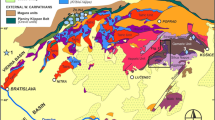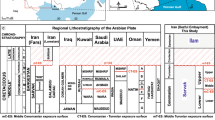Abstract
In order to evaluate the mobility of trace elements during subduction metamorphism, the geochemistry of blueschists of the Dzhebash Group from the Kurtushibinsky Range of the Western Sayan (basins of the Koyard and Oresh rivers) was studied, and the chemical compositions of high-pressure rocks were compared with weakly altered basalts from the same region. The protoliths of the blueschists were probably metabasalts of similar age from the ophiolitic dike complex, the pillow lavas of the Verkhnekoyardsky Formation crowning them, and the pillow basalts of the Kurtushibinsky Formation. The spatial association of the blueschists with the Kurtushibinsky Formation basalts and identical trace element patterns in these rocks allow us to suppose the cogenetic character of their protoliths. Geological and geochemical data suggest their formation in an oceanic plateau setting, whereas the mafic rocks of the dike complex and the Verkhnekoyardsky Formation show island-arc affinity. A comparison of the Dzhebash Group blueschists with the chemically equivalent Kurtushibinsky basalts showed that high-pressure metamorphism caused only minor changes in their compositions. These rocks are almost indistinguishable with respect to such fluid-immobile components as Ti, P, Zr, Hf, Y, and middle and heavy rare earth elements. On the other hand, the blueschists are strongly depleted in potassium. The selective removal of Rb and Ba during blueschist metamorphism was observed only in those samples that showed the most extensive removal of potassium.
Similar content being viewed by others
References
W. M. White and B. Dupre, “Sediment Subduction and Magma Genesis in the Lesser Antilles: Isotopic and Trace Element Constraints,” J. Geophys. Res. 19, 5927–5941 (1986).
C. J. Hawkesworth, J. M. Hergt, F. McDermott, and R. M. Ellam, “Destructive Margin Magmatism and the Contributions from the Mantle Wedge and Subducted Crust,” Austral. J. Earth Sci. 38, 577–594 (1991).
C. J. Hawkesworth, K. Gallagher, J. M. Hergt, and F. McDermott, “Mantle and Slab Contributions in Arc Magmas,” Ann. Rev. Earth Planet. Sci. 21, 175–204 (1993).
V. G. Batanova, A. V. Sobolev, and H.-U. Schminke, “Parental Melts of the Intrusive Cumulates of the Troodos Massif, Cyprus: A Study of Clinopyroxenes and Melt Inclusions in Plagioclase,” Petrologiya 4, 273–282 (1996) [Petrology 4, 255–264 (1996)].
D. Ben Othman, W. M. White, and J. Patchett, “The Geochemistry of Marine Sediments, Island Arc Magma Genesis, and Crust-Mantle Recycling,” Earth Planet. Sci. Lett. 94, 1–21 (1989).
T. Elliott, T. Plank, A. Zindler, et al., “Element Transport from Slab to Volcanic Front at the Mariana Arc,” J. Geophys. Res. 102, 14991–15019 (1997).
T. Plank and C. H. Langmuir, “Tracing Trace Elements from Sediment Input to Volcanic Output at Subduction Zones,” Nature 362, 739–743 (1993).
T. Plank and C. H. Langmuir, “The Chemical Composition of Subducting Sediment and Its Consequences for the Crust and Mantle,” Chem. Geol. 145, 325–394 (1998).
R. Kilian and J. H. Behrmann, “Geochemical Constraints on the Sources of Southern Chile Trench Sediments and Their Recycling in Arc Magmas of the Southern Andes,” J. Geol. Soc. 160, 57–70 (2003).
H. Becker, K. P. Jochum, and R. W. Carlson, “Trace Element Fractionation during Dehydration of Eclogites from High-Pressure Terranes and the Implications for Element Fluxes in Subduction Zones,” Chem. Geol. 163, 65–99 (2000).
D. M. Kerrick and J. A. D. Connolly, “Metamorphic Devolatilization of Subducted Oceanic Metabasalts: Implications for Seismicity, Arc Magmatism and Volatile Recycling,” Earth Planet. Sci. Lett. 189, 19–29 (2001).
S. Poli and M. W. Schmidt, “Petrology of Subducted Slabs,” Annu. Rev. Earth Planet. Sci. 30, 207–235 (2002).
J. M. Hall, C. C. Walls, J-S. Yang, et al., “The Magnetization of Oceanic Crust: Contribution to Knowledge from the Troodos, Cyprus, Ophiolite,” Can. J. Earth Sci. 28, 1812–1826 (1991).
P. Spadea, L. Beccaluva, M. Coltori, et al., “Petrology of Igneous Rocks from the Seafloor of the Sulu and Celebes Sea,” Ofioliti 17, 79–93 (1992).
S. I. Dril, M. I. Kuzmin, S. S. Tsipukova, and L. P. Zonenshain, “Geochemistry of Basalts from the Western Woodlark, Lau and Manus Basins: Implications for Their Petrogenesis and Source Rock Compositions,” Mar. Geol. 142, 57–83 (1997).
R. Hekinian and G. Thompson, “Comparative Geochemistry of Volcanics from Rift Valleys, Transform Faults and Aseismic Ridges,” Contrib. Mineral. Petrol. 57, 145–162 (1976).
M. Wilson, Igneous Petrogenesis (Kluwer, Dordrecht, 1989).
T. John, E. E. Scherer, K. Haase, and V. Schenk, “Trace Element Fractionation during Fluid-Induced Eclogitization in a Subducting Slab: Trace Element and Hf-Sm-Nd Isotope Systematics,” Earth Planet. Sci. Lett. 227, 441–456 (2004).
C. Spandler, J. Hermann, R. Arculus, and J. Mavrogenes, “Geochemical Heterogeneity and Element Mobility in Deeply Subducted Oceanic Crust; Insights from High-Pressure Mafic Rocks from New Caledonia,” Chem. Geol. 206, 21–42 (2004).
N. L. Dobretsov and L. G. Ponomareva, “Ophiolites and Glaucophane Schists of the Western Sayan and Kurtushubin Belt,” in Petrology and Metamorphism of Ancient Ophiolites with Reference to the Polar Urals and Western Sayan, Ed. by V. S. Sobolev and N. L. Dobretsov (Nauka, Novosibirsk, 1977), pp. 128–156 [in Russian].
Ya. V. Sarbaa, V. F. Tokunov, V. G. Varenik, et al., Geological Structure and Mineral Resources of the Koyard, Oresh, Omul, Sterlig, and Turan Rivers within Sheets N-46-128-A(V, G), B(V, G), V, G. (Final Report on Prospecting Operations of 1970–1972 on a Scale of 1:50 000 of the Oresh Geological Prospecting Party) (TTFGI, Kyzyl, 1973) [in Russian].
A. K. Sibilev, Petrology and Asbestos Potential of Ophiolites by the Example of the Idzhim Massif in the Western Sayan (Nauka, Novosibirsk, 1980) [in Russian].
S. A. Kurenkov, A. N. Didenko, and V. A. Simonov, Geodynamics of Paleospreading (GEOS, Moscow, 2002) [in Russian].
S. I. Stupakov and V. A. Simonov, “Mineralogical Features of Ultrabasites: Criteria of Paleogeodynamic Settings of Ophiolites from the Altai-Sayan Fold Area,” Geol. Geofiz. 38, 746–755 (1997).
G. G. Duk, Glaucophane-Greenschist and Ophiolite Complexes of the Ural-Mongol Fold Belt (IGGD RAN, St. Petersburg, 1995) [in Russian].
V. S. Shatskii, E. S. Sitnikova, O. A. Koz’menko, et al., “Behavior of Incompatible Elements during Ultrahigh Pressure Metamorphism by the Example of the Rocks of the Kokchetav Massif,” Geol. Geofiz. 47, 485–498 (2006).
G. E. Bebout, J. G. Ryan, W. P. Leeman, and A. E. Bebout, “Fractionation of Trace Elements during Subduction-Zone Metamorphism: Impact of Convergent Margin Thermal Evolution,” Earth Planet. Sci. Lett. 171, 63–81 (1999).
G. E. Bebout, “Metamorphic Chemical Geodynamics of Subduction Zones,” Earth Planet. Sci. Lett. 260, 373–393 (2007).
J. M. Brenan, H. F. Shaw, D. L. Phinney, and F. J. Ryerson, “Rutile-Aqueous Fluid Partitioning of Nb, Ta, Hf, Zr, U and Th: Implications for High Field Strength Element Depletions in Island-Arc Basalts,” Earth Planet. Sci. Lett. 128, 327–339 (1994).
T. Kogiso, Y. Tatsumi, and S. Nakano, “Trace Element Transport during Dehydration Processes in the Subducted Oceanic Crust: 1. Experiments and Implications for the Origin of Ocean Island Basalts,” Earth Planet. Sci. Lett. 148, 193–205 (1997).
S. S. Sun and W. F. McDonough, “Chemical and Isotopic Systematics of Oceanic Basalts: Implications for Mantle Compositions and Processes,” in Magmatism in the Ocean Basins, Ed. by A. D. Saunders and M. J. Norry, Geol. Soc. Spec. Publ. 42, 313–345 (1989).
E. M. Klein, “Geochemistry of the Igneous Oceanic Crust,” in Treatise on Geochemistry, Ed. by R. Rudnick (Elsevier, 2003), Vol. 3, pp. 433–463.
A. D. Saunders, M. J. Norry, and J. Tarney, “Origin of MORB and Chemically Depleted Mantle Reservoirs: Trace Element Constrains,” J. Petrol. Spec. Lithosphere Issue, 415–445 (1988).
R. Tribuzio, B. Messiga, R. Vannucci, and P. Bottazzi, “Rare Earth Element Redistribution during High-Pressure-Low-Temperature Metamorphism in Ophiolitic Fe-Gabbros (Liguria, North-Western Italy): Implications for Light REE Mobility in Subduction Zones,” Geology 24, 711–614 (1996).
J. Gao, T. John, R. Klemd, and X. Xiong, “Mobilization of Ti-Nb-Ta during Subduction: Evidence from Rutile-Bearing Dehydration Segregations and Veins Hosted in Eclogite, Tianshan, NW China,” Geochim. Cosmochim. Acta 71, 4974–4996 (2007).
A. W. Hofmann, K. P. Jochum, R. Vannucci, and P. Bottazzi, “Nb and Pb in Oceanic Basalts: New Constraints on Mantle Evolution,” Earth Planet. Sci. Lett. 79, 33–45 (1986).
N. I. Volkova and E. V. Sklyarov, “High-Pressure Complexes of the Central Asian Fold Belt: Geological Setting, Geochemistry, and Geodynamic Implications,” Geol. Geofiz. 48, 109–119 (2007).
Author information
Authors and Affiliations
Corresponding author
Additional information
Original Russian Text © N.I. Volkova, S.I. Stupakov, G.A. Babin, S.N. Rudnev, A.A. Mongush, 2009, published in Geokhimiya, 2009, No. 4, pp. 401–414.
Rights and permissions
About this article
Cite this article
Volkova, N.I., Stupakov, S.I., Babin, G.A. et al. Mobility of trace elements during subduction metamorphism as exemplified by the blueschists of the Kurtushibinsky Range, Western Sayan. Geochem. Int. 47, 380–392 (2009). https://doi.org/10.1134/S0016702909040053
Received:
Published:
Issue Date:
DOI: https://doi.org/10.1134/S0016702909040053




